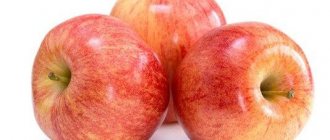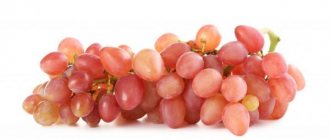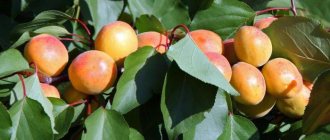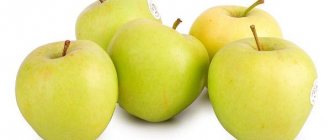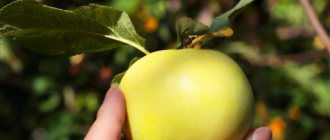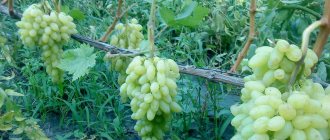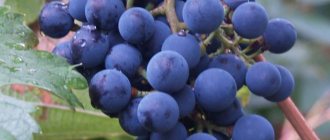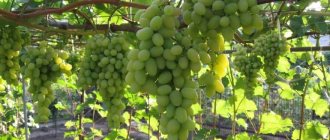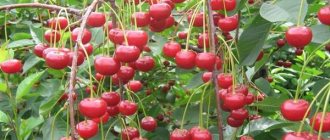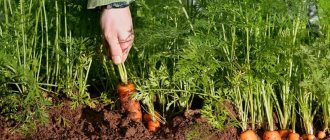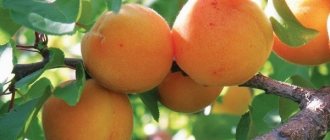History of Gala grape breeding
“Gala” was bred by the Ukrainian breeder Zagorulko V.V. by crossing “Kodryanka” and “Gift to Zaporozhye” in a region with a temperate continental climate.
Immediately after its appearance on the market, the variety was sold at high prices (more than 2,000 rubles per seedling ) due to its outstanding qualities.
At the moment, seedlings can be purchased for no more than 100-200 rubles , due to the fact that breeders managed to propagate this variety, but it has not lost its remarkable properties.
Growing the variety
Growing conditions
Gala grapes are grown by cuttings. You need to choose a quality seedling. There should be no physical damage, stains or signs of infection.
The variety has good adaptability to new conditions, but it is better to plant several cuttings in one hole so that they will take root.
It is better to grow Gala in warm climates. The area should be well lit and protected from drafts. It should be planted in loose soil so that the root system has enough moisture and oxygen.
Planting in the soil
It is best to plant Gala grapes in the ground in early spring, when it is already warm outside. Before planting, the seedlings are pruned. The roots and shoots are shortened, leaving only the strongest segments.
Disembarkation sequence:
- dig a hole 60-80 cm deep;
- fill its bottom with a mixture of soil and fertilizers;
- plant a seedling in a hole;
- cover with a layer of earth on top without compacting.
The distance between the bushes should be 2-2.5 m. Also, depressions are made around the bush for mulching with leaves or straw, which allows them to retain moisture during the cold seasons.
Plant care
It is necessary to monitor the number of bunches.
Gala grapes require regular care. During the fruiting period, make sure that the bunches are not overloaded and the branches are not broken. Autumn pruning of vines and buds is also carried out.
For the winter, the grapes are covered with a layer of soil, and in the spring the cover is removed when the temperature reaches warm at night. In summer, care consists of tying up branches and inspecting the bush for diseases.
Fertilizer
The following minerals are added as fertilizer:
- nitrogen (ammonium nitrate and urea);
- phosphorus (double granulated superphosphate);
- potassium (potassium salt, potassium chloride, Ecoplant).
There are complexes that contain all the necessary substances. The first fertilizers are applied immediately after removing the winter shelter. A mixture of 35 g of superphosphate, 25 g of potassium and 40 g of nitrogen per plant is added to the soil.
The second feeding is applied 14 days before the start of the flowering period. An aqueous solution of chicken manure is added to the soil in a ratio of 1:6. You can also add potassium fertilizer and superphosphate to the mixture.
Fertilizers are applied at the beginning of the berry ripening period. To do this, use 50 g of phosphorus and 25 and superphosphate per 1 bush.
Watering
- the first watering is carried out immediately after planting or gartering;
- the second - 7 days after pruning;
- the third is carried out to accelerate growth at a shoot height of 35 cm;
- the fourth application of moisture is carried out a week before flowering;
- fifth - when ripe berries appear;
- the sixth watering is carried out before harvesting.
Watering is also carried out at the end of autumn to obtain moisture for the plant for the winter. Superphosphate and ash are added to the water. Young plants are watered using tubes in the ground. They also dig holes 45 cm deep near the bush and add moisture to them.
general information
Type of variety: table.
Berry color: blue . Just like Augusta, Witch's Fingers and Karmacode.
“Gala” is an early ripening variety that produces large juicy berries with a bright taste and attractive appearance.
Thanks to its rapid ripening, Gala grapes are ready for consumption earlier than many other varieties, which makes them highly competitive in the market and popular among gardeners with different levels of experience.
The Moor, Angelica and Valek are also distinguished by their precocity.
Characteristics of the variety
Gala grapes are fast-ripening table grapes. The period during which the berries reach maturity from the beginning of the growing season is 120-130 days. Has stable and high yield. Frost resistance and immunity to disease are average. The bushes feel normal at temperatures down to -18 ℃. According to the description of the variety, its disadvantage is its capriciousness in terms of growing and care conditions.
Description of the bush
The bush has a similar description to other early-fruiting varieties. The vine reaches 2 m in height. The leaves are large in size and rich green in color.
Gala grape flowers are hermaphrodites. The load on the branches is average.
Description of fruits
According to the description, the fruits of the Gala grape are oval and ovoid in shape. The average weight of 1 berry is 8.5 g, and the weight of the vine reaches 700 g.
The taste is the same as that of other table varieties. The berries are sweet with a slight sourness in the aftertaste. The pulp is dense and juicy. The fruits grow densely in large conical clusters.
Description of the variety
- Berry shape: ovoid.
- Taste of berries: sweet with sourness.
- Average vine weight: 750 g.
- Average weight of berries: 9 g.
- Acidity - 6.8 g/l, sugar content - 16.5%.
The berries grow intensively and densely, in large conical vines. The leaves are of considerable size. Flowers are hermaphrodites. The berries do not pea (small and unripe berries are not formed as a result of lack of pollination).
Ripening period: 110-125 days (early ripening).
Productivity: high and stable, fruiting coefficient - 1.3.
Frost resistance: average (the bush can withstand temperatures down to -21⁰С ).
Super Extra, Beauty of the North and Pink Flamingo also boast good frost resistance.
“Gala” ripens early, which is why there is no need to delay harvesting, otherwise the berries will overflow with liquid and begin to burst, which attracts wasps.
The level of frost resistance of the variety is sufficient to grow it in the regions of central and central Russia with mandatory shelter.
Advantages:
- consistently high productivity;
- resistance to diseases and pests;
- The berries are superior in taste and appearance to many other varieties.
Flaws:
- requires careful care;
- average frost resistance.
Reviews
Today, Gala grapes are chosen by winegrowers as a crop suitable for growing in greenhouse conditions. If the soil is adapted for growing this variety, then this allows you to collect bunches of up to 2 kg. But, like all hybrids, there is a problem with pollination, this can be seen from the uneven ripening of the berries.
To date, the hybrid form “Gala” has already been tested by winegrowers as a crop for growing in a greenhouse. In protected soil, the variety performed very well and allows you to obtain bunches weighing up to 2 kg. However, certain problems have been noticed with pollination, which is reflected in some unevenness of the berries.
“Gala” ripens well and does not cause much trouble for the gardener when cultivating in his or her personal plot.
The hybrid form of the Gala grape compares favorably with other new early-ripening dark-colored varieties by its high level of fruiting stability and reliability. Such grapes really deserve the attention of amateur gardeners due to their excellent marketability and the opportunity to get an early harvest.
Galia, like many other forms of V.U. Kapelyushny, found both her admirers and strict critics. Among those who criticize these grapes are mainly professional winegrowers, for whom not only the characteristics of the variety are important, but also its uniqueness, obvious differences from other varieties. The disadvantages are often noted, firstly, unstable pollination and, secondly, a tendency for berries to pea (which is often a consequence of poor pollination or overloading of the bush).
In positive reviews of the variety, gardeners note the early ripening period and the pleasant taste of the berries.
Galia has not received such wide popularity as similar varieties, for example, Richelieu. But its advantages - very early ripening, ease of care and high-quality tasty berries - make the variety a desirable acquisition for many winegrowers and amateur gardeners.
Properly executed agricultural technology, which consists of watering, fertilizing, pruning the crop and protecting it from pests, ensures a stable and rich grape harvest.
Watering and fertilizers
Excessive watering is detrimental to Gala, so plants should be moistened correctly. The first moistening is carried out after planting the plant, all subsequent ones - as the soil dries out. Grapes need the most moisture during the growing season. At this time, it is abundantly moistened by pouring from 60 to 80 liters of warm, settled water into the holes dug around the bush, depending on weather conditions.
Irrigation should be stopped when the crop has entered the flowering phase. Due to the large amount of moisture, the flowers will begin to crumble, which will lead to a decrease in the amount of harvest. You should also not water the grapes while the berries are ripening, as their skins will crack. To ensure maximum proper hydration, you should organize a drainage irrigation system or make several depressions around the trunk, 35–40 cm deep.
We must not forget about regular application of fertilizers, to which Gala reacts very positively. It is recommended to alternately add organic and mineral products. The first feeding is carried out immediately after winter, the second and subsequent ones - before and after the flowering period.
Important! Young plants can develop excellently without fertilizers. But crops older than 3 years need at least three feedings per season.
When caring for Gala, it is necessary to prune and shape the bush. If this measure is neglected, the load on the plant will increase, which will negatively affect the size of the fruit and its taste.
Pruning should be done in early spring or autumn. During autumn pruning, long shoots are shortened, leaving a maximum of 8 buds. In this case, the total number of eyes on the bush should not exceed 45. Spring shaping is aimed at removing dry, woody or weak shoots. In addition, it is used to standardize harvest volumes - two bunches are left on some shoots, and one on another.
Mulching
The mulching procedure, which is carried out throughout the entire growing season of the grapes, starting from the moment the seedling is planted and ending with immersing the crop in a state of winter sleep, allows you to retain a sufficient amount of moisture in the soil, protect the grapes from weeds, and enrich the soil with oxygen and valuable components.
Did you know? If you sow parsley under a grape bush, it will be healthier and stronger. The thing is that greenery protects the plant from pests and inhibits the growth of weeds.
Covering
Method 1:
- Carefully collect all the branches of the bush, tie them with an elastic, but not rigid rope, lay them on a special bedding material and secure them.
- Install metal arches into the ground near the bush and stretch plastic film over them.
- Sprinkle the structure on all sides with soil to protect it from sharp gusts of wind or heavy snowfall.
Method 2:
- Collect the branches of the plant, tie them, and place them on the previously prepared bedding.
- Cover with a fairly large layer of soil.
The latter method can be practiced in regions with moderate climatic conditions, where temperatures in winter do not fall below -15°C.
The variety is quite resistant to frost, able to withstand down to -21 degrees. So this grape has average frost resistance.
Roman, Krivoy Rog
Gregory, Tver
The grape bushes are vigorous with a fairly massive trunk and strong branches. The leaves are medium to large in size, light green with pronounced golden-yellow veins, serrated at the ends. Their shape resembles black currant leaves. The flower is bisexual.
Princess Olga and Jubilee of the Kherson summer resident also have bisexual flowers.
The bunch has a regular cylindrical-conical shape, medium density or slightly loose, large. Weight from 600 to 1100 grams.
Medium sized berries (27x21 mm). With proper care and regular feeding, larger ones (33x25 mm) are formed.
The average weight of each is 10 grams, up to a maximum of 13-15 grams. The berries are light green, and when ripe they acquire a beautiful amber-yellow hue and are covered with a matte, waxy coating.
The pulp is fleshy, juicy, tasty, the skin is thin and is almost not felt when eating. Grapes contain up to 21 g/100 cm3 of sugar content with an acidity of 5-6 g/dm3.
It is worth noting that Galahad received a high tasting taste score, which amounted to about 9 points.
The variety is best suited for fresh, unchanged consumption, as well as for making homemade jam, jam, pastries and other sweet dishes.
Varieties such as Korolek, Aleshenkin Dar and Ataman are recommended for fresh consumption.
There are several important points that are worth knowing before you get such a bush. Firstly, you need to familiarize yourself with the characteristics of the variety, and secondly, with the rules for caring for it. This will help you in your choice and will prevent you from making mistakes later during cultivation. So, what are “Gala” grapes:
- the berries have an elongated oval shape and delicate pulp, the sweet taste of the grapes has a slight sourness;
- the brushes have an impressive cone-shaped appearance, and each berry can reach nine grams; as a result, you can get very large brushes;
- large leaves help create good shade, so many people plant this variety not only for the sake of the harvest, but also for the design of a gazebo or arch;
- the plant pollinates on its own, so there are no problems with the ripening of berries, as well as with underdeveloped tassels, as in many other varieties;
- excellent frost tolerance makes it possible to grow these grapes in regions with cold climates; they winter quietly at a temperature of -21;
- the advantage of the variety is considered to be its ability to resist attacks from diseases and pests; often the owner does not need to additionally treat the plant with chemicals;
- the disadvantage is the fact that if you do not harvest on time, the berries begin to crack and juice flows out, which attracts wasps.
To summarize, I would like to note that reviews from gardeners clearly show all the advantages of this variety. The plant does not require special care, but the harvest exceeds all expectations. This type is especially praised by those who make money by selling early grape varieties. People are happy to buy berries that they missed during the winter.
Diseases and pests
Disease resistance: high (resistance to mildew and oidium 33.5 points ).
Grapes of the "Gala" variety almost do not attract pests if harvested on time - wasps prefer the fruits of predecessor varieties.
Significant resistance to diseases and fungi is one of the main breeding advantages of the variety, since the use of chemical treatments is often not required.
As for the prevention of diseases such as anthracnose, chlorosis, bacteriosis and rubella, you can read this information in detail in separate materials on the site.
Advantages of the variety
Like most new hybrid forms obtained from the most successful parental lines, the Gala grape demonstrates the following advantages:
- stability of high and early yields;
- decent taste;
- good resistance to the most dangerous fungal diseases for grapes, including mildew, oidium (by 3-3.5 points);
- frost resistance up to - 21 ° C;
- good ripening of the vines;
- high level of rooting.
When cultivating this hybrid form, it is necessary to remember such a disadvantage as the tendency of the berries to crack if the weather is too rainy.
Care
Since “Gala” will produce a consistently high yield, the vines must be unloaded by pruning them to avoid loss of the taste of the berries and the speed of their ripening.
This is done in the fall, before covering for the coming cold.
When pruning a bush, always leave at least 35-40 buds , and shorten the vines by no more than 8 buds.
Bushes of the "Gala" variety practically do not need protection from pests due to their natural resistance, however, for the purpose of prevention, the bushes can be treated with fungicides or Bordeaux mixture of 1% concentration.
Treatment is carried out immediately before flowering.
Covering bushes for the cold season: tie the bushes, lay them on a specially laid material, fasten them, install metal arches on top, onto which polyethylene is then stretched.
An adult Gala bush will need much more fertilizer than a young seedling.
Care Tips
Gala grapes do not belong to particularly capricious varieties, but still require some attention. To ensure that the bush grows and develops properly, follow the advice of experts:
- Constantly monitor the formation of the bush to prevent the vine from becoming overloaded. Too many clusters on the vine cause the grapes to become sour and small and to ripen slowly. It is best to carry out the circumcision procedure in the autumn before the onset of frost.
- When pruning grapes, carefully study the information on how to do it correctly. After pruning, at least thirty buds and eight eyes should remain on the branch.
- During the growing process, it is recommended not to neglect treating the bush with special means that prevent various diseases from appearing. Despite the fact that this variety is resistant to disease, there is no need to hope for absolute resistance, but rather to help the plant and protect yourself from crop loss. This must be done before the grapes begin to bloom.
- For the winter period, we recommend covering the bush, especially if you live in a region where frost can be more than -21 degrees.
- Like any plant, Gala grapes need nourishment, especially when the seedling turns into an adult plant.
Landing
It is better to plant in late spring, when the cold weather has completely subsided.
Before planting, the seedling must be pruned - both roots and shoots (sluggish ones should be cut off completely). This will contribute to the correct and unhindered growth of the bush.
The planting hole should measure about 80 centimeters in length, width and depth, while half the depth is filled with fertile soil mixed with 2-3 buckets of fertilizer .
The distance between pits for different bushes is at least two meters.
Around the seedling installed in the hole, you need to make a small hole to create a layer of mulch (leaves, humus, straw), which is necessary to retain moisture. The layer is then renewed up to the shelter for the winter.
How to plant grapes
To achieve regular fruiting and high quality fruits, it is necessary to adhere to the basic rules when planting a plant.
Selection of seedlings
Further growth and development of grapes will, first of all, depend on the condition of the planting material. Experts recommend purchasing seedlings from trusted places, special nurseries or from familiar gardeners who can guarantee the quality of the material.
Before purchasing a seedling, you should conduct a visual inspection of it for mechanical and biological damage, including symptoms of disease.
Signs of poor planting material are:
- The presence of dry, rotten, damaged root shoots. A healthy root should have a milky white color when cut, resembling a cut potato. A dark, dry cut area indicates tissue necrosis.
- Lack of vaccination site. The grafting site should be clearly visible on the trunk of the seedling. If it is not there, then it is better to refuse to purchase this material.
- The presence of a large number of leaves and a woody trunk. The foliage that remains on the trunk “steals” the plant’s supply of moisture and nutrients, due to which it takes root poorly and, as a result, does not bear fruit well.
- The presence of dry, black vines and bark. Experts recommend making small cuts on the vine: in a healthy plant they are moist and have a fresh green color. Dull color and lack of juice indicate that the planting material is “dead”. The same goes for the bark: the places where it was scraped should be green or gray in color.
Vip magic || Vip magic || Full moon fortune telling: types, rules and interpretation
Site preparation
It is recommended to plant seedlings in the spring, when the risk of night return frosts is minimal. A well-lit area with no cold winds or drafts is perfect for Gala grapes. The variety prefers loose, soft soils with an average degree of salinity. Before planting, you need to loosen the soil well so that it is enriched with oxygen and nutritional components.
Landing technology
Before immersing seedlings in the soil, they should be thoroughly “inspected”: cut off dry, rotten and too long root shoots, and treat the cut areas with crushed charcoal.
Next, it is recommended to plant the plant using the following technology:
- Dig a hole measuring 80x80x80 cm.
- Line the bottom of the hole with a layer of drainage, and on top - a layer of fertile soil, about 30 cm high.
- Add 2-3 buckets of organic fertilizers and superphosphates to the hole.
- Lower a seedling into the hole at a slight slope, on which there are shoots with at least 2-3 buds.
- Bury the seedling approximately 10 cm deep with fertilized soil and cover it with regular soil on top. Do not compact.
- In the hole, leave a distance at the top for watering the plant (about 5–10 cm).
- Make a groove around the hole, within a radius of 15 cm, which is filled with mulch.
When planting several bushes, the distance between them should be at least 2.5 m.
Watering
Proper watering is carried out exclusively through additional shallow holes with a diameter of up to 40 cm - they are dug at a short distance from the bush.
This method allows you to properly control the water balance of the soil and not flood the bush.
The standard watering volume is 1-2 buckets .
The number of waterings is strictly defined.
The first watering is done after planting (or after gartering).
The second watering - a little later, after pruning - no later than a week.
The third watering is needed to stimulate growth when the shoots have grown to 30 cm in height .
The fourth watering is carried out before the flowering period.
The next, fifth, watering is when the berries reach a size of about 0.5 cm in diameter.
The sixth watering is done to improve the quality of the crop, shortly before harvest.
The last watering is done before sheltering for the winter.
Before the shelter, moisture-charging watering is carried out - the volume of watering is increased by several liters, it is advisable to add superphosphate.
Disembarkation and care
If you want to grow “Gala” on your site, all the necessary information regarding this issue is provided below.
How to plant
The best time to plant “Gala” is spring, since during the summer and autumn the seedlings have better time to take root and prepare for wintering.
Before starting the procedure, you need to slightly process the seedling. Firstly, when choosing it, pay attention to the presence of mechanical damage and traces of disease (spots, growths). The roots of the selected seedling are cut off, the shoot is shortened, and weak parts are cut off.
Holes measuring 0.8 m3 are prepared in advance. If you want to grow several bushes, then the distance between the holes should be at least 200 cm. The first 30 cm of the holes are filled with soil mixed with fertilizers. Next, the seedling is installed and the hole is filled with earth, but not completely, but leaving a depression of 4-8 cm to the ground level, which is necessary for watering. A small depression is made within a radius of 15-20 cm from the seedling, which is filled with mulch and watered.
Mulching
Mulch is a special material that covers the soil. It allows you to retain moisture in the soil, maintains the temperature regime, preventing overheating or overcooling of the soil. At the same time, mulch nourishes the earth with carbon dioxide and other beneficial substances.
The procedure is performed regularly throughout the growing season. Particular attention is paid to mulching before covering the grapes for the winter; at this time, the mulch layer should be at least 10 cm.
Watering
As you know, “Gala” grapes are a moisture-loving plant, and therefore they need to be watered regularly and abundantly. The only caveat is that watering is contraindicated during the flowering period of the berries due to the fragility of the flowers, which, if severely damaged, do not turn into berries.
During the growing season, the bush needs about 50 liters of water per watering, and before winter shelter - at least 70 liters. For proper distribution of liquid, it is recommended to dig a hole around the shoot with a diameter of 40-50 cm.
If groundwater is closer than 2 meters, then drainage is done during planting, and crushed stone or pebbles are laid out in the hole as the first layer.
Watering is carried out immediately after planting, then repeated a week later. Next, the procedure is repeated when the seedlings reach a height of 30-35 cm. The next watering is done before the bush blooms, and then after the formation of small berries (03.05 mm). The penultimate time the bush can be watered is just before harvesting.
Trimming
Regular pruning is necessary in order to avoid overloading the bunches, which has negative consequences in the form of deterioration in the quality of the berries (smaller size, weight, loss of richness of taste).
The procedure is carried out before winter shelter, no more than 8 eyes are left on each vine, and for the entire bush the optimal number of buds is 40-45 pieces.
Fertilizer
Grapes need to be fertilized constantly, with the exception of undeveloped cuttings. Organic matter (soil, peat, humus, manure) is excellent. The proportion is maintained at the rate of 10 kg per 1 square meter of land.
Fertilizing with minerals is carried out once a year. In the spring, Gala is fertilized with nitrogen, and potassium is added to the soil before and after the flowering period.
Treatment for parasites
As already, it is highly resistant to fungal parasites and mildew, so the likelihood of infection is very low. Therefore, whether to carry out prevention or not – the gardener should decide for himself. Bordeaux mixture is used for processing.
Shelter for the winter
If the temperature in your region drops below 10 degrees Celsius, the bush should be covered before winter. To do this, it is carefully collected and tied with rope. The bushes are laid on pre-prepared bedding. Ordinary potato bags are suitable as insulation.
We invite you to familiarize yourself with other grape varieties on our website: “Ruslan”, “Galahad”, “USA Jupiter”, “Muromets”, “In Memory of the Teacher”, “Merlot”, “Helios”, “Beauty of Nikopol”, “Friendship” .
Description and characteristics of the Krasen grape variety, selection history and cultivation characteristics
History of appearance
The author of this species is V.V. Zagorulko, a breeder from Ukraine. I experimentally crossed two grape varieties and got an excellent result. Species participating in the experiment:
Initially the price was very high. The seedlings were sold at a high price due to the outstanding qualities that the grape bushes possessed. Over time, other competitive varieties appeared, and the price was reduced.
This variety was bred at VNIIViV named after. Potapenko. The culture was obtained as a result of pollination of muscats of the Severny variety. Experts managed to obtain a variety that adapted well to the harsh climate and did not have primitive characteristics. Today Denisovsky grapes are actively grown in the Caucasus.
Description and characteristics of Denisovsky grapes
The grapes of this variety belong to the category of technical varieties. The plant is characterized by brown, vigorous shoots. The bush has a developed root system. The culture is resistant to the development of fungal infections. When pruning, it is recommended to leave 35 eyes per bush.
The plant is characterized by slightly pubescent leaves along the lower edge. They differ in their dissected structure. Red shoots are characterized by an average yield - it is 65-75%. When pruning the plant in autumn, it is worth leaving a length of 6-7 eyes. When planting 3 bushes on 1.5 square meters, it is possible to achieve an average yield of about 4 kilograms of fruit per bush.
Description and cultivation of table grape variety "Gala"
I decided to plant a new grape variety in my garden - Gala. I have long wanted to grow grapes, but I was confused by the fact that I do not live in the south.
Gala grapes are a frost-resistant plant, so I turned my attention to them. First, I found information about different varieties, read reviews from experienced gardeners and settled on this.
I succeeded: I was able not only to grow grapes and harvest them, but also to start growing them myself, and quite successfully.
Characteristics of the variety
Gala grape variety is a fast-ripening variety. The period of full maturity (from the beginning of active spring growth) is 4 - 4.5 months. Brings a stable and rich harvest. Frost resistance and sensitivity to disease are average. The shoots grow well and bear fruit at temperatures down to -18 C.
From the description of the variety it is clear that at the same time, this crop is quite demanding in terms of the growing conditions provided to it and quality care.
Description of the plant
The bush looks similar to other early ripening varieties. The vine gains about 2 m in height. The leaves are large burdocks, bright green.
The flowers of the Gala hybrid are asexual. The fruit filling of the vine is average.
Description of fruits
According to the description, Gala berries are oval-shaped. On average, the weight of 1 berry is 8.5 g, and the mass of the entire vine is 700 g. The taste of Gala berries resembles other table grape varieties.
When you bite into it, the berries are sweet at first, but then some sourness appears. The pulp of the berry is elastic and juicy. The fruits are located close to each other and collected in huge cone-shaped clusters.
- constant yield;
- excellent taste;
- low sensitivity to fungal diseases.
- frost resistance leaves much to be desired;
- The berries burst when there is too much water.
Landing
It is advisable to plant this variety in open ground in the spring, when the threat of residual frost has passed. When purchasing a shoot, it is carefully examined for the presence of mechanical damage and damage from past diseases. Before planting, the roots of the seedling are thinned out.
This is how the roots are renewed. But that’s not all, the old is also cut off. If there are 2 or more shoots, then the weakest and thinnest ones are removed. There should be 2 - 3 eyes on one vine.
Planting of grape seedlings is carried out in pre-prepared holes, the size of which is 80x80x80 cm, the gap between plants is 2 - 3 m. The bottom of the hole is laid out in layers of 30 - 40 cm of fertile soil mixed with organic fertilizers (2 - 3 buckets in each hole) and superphosphate .
A shoot is placed on a layer of fertile soil, and the neck of the root is sprinkled with 5–10 cm of fertilized soil. Next, the hole is filled with ordinary soil, but 5–10 cm of the remaining height does not reach the very top and must be left for watering.
Near the shoot itself, dig a small hole of 30 cm with your hands. After planting, you need to pour water into it and fill it with a layer of mulch.
To ensure a happy harvest, you need to follow all agrotechnical requirements that have a positive effect on the plant. Ongoing events:
The applied mulch controls the water balance in the soil, protects against low temperatures, and ensures the supply of oxygen and nutrients to the root system. The mulching procedure is carried out throughout the growing season: from planting to hibernation.
Before sheltering, the plant is insulated: covered with peat, straw, humus. Organic mulch should occupy no more than 10 cm. Stagnant water also negatively affects the plant. The variety needs watering throughout the entire period of active growth, flowering and fruiting.
But this must be carefully monitored, taking into account the changeable weather, the characteristics of the climate zone, and the qualitative composition of the soil. Active growth continues from April to October. Watering is strictly prohibited during the flowering period of the vine. Peduncles may fall off and fruits may not form.
Immediately before storing the shoots for the winter, they need to be well moistened: the water will be useful throughout the winter. You need to pour under each bush: 70 l/1 sq.m; during the growing season 50 l/1 sq.m.
If the water gets very close to the roots, then the bush no longer requires moisture. It is better to reduce its quantity. Drainage will help with this.
If you listen to the opinions of experienced gardeners, Gala needs feeding constantly. Only young cuttings do not require fertilization.
For teenage bushes, organic matter is suitable (compost, peat, humus), which is applied: 10 kg / 1 sq.m 3 times. Minerals are added every year. In the spring, after the ground has “moved away” from snow and ice, ammonium nitrate or nitrogen is added to it.
Before flowering begins and after it ends, at the moment of formation of pea fruits on the clusters, you need to add potassium salts and superphosphate to the soil. This guarantees a good harvest.
Gala welcomes timely pruning. When the vines are overloaded, the berries become smaller and lose their taste. The strength for proper shoot formation is insufficient, which affects the quality of the fruit.
Water thoroughly after planting
Stage 1. Prepare planting material
| |
Stage 2. Select a location and dig a hole
| |
Stage 3. Fill the hole with a nutrient mixture
| |
Stage 4. Plant the plant
| |
Stage 5. Water the seedling
|
Agrotechnical features
The economic characteristics of the grapes can be assessed as quite good. In relation to our heroine, one cannot complain about excessive pampering or the need for any specific care for her. The main activities in the vineyard correspond to the traditional cultivation techniques for the crop, and only a few features distinguish it from other moderately resistant varieties.
Planting should be carried out in areas suitable for viticulture. The hybrid form grows equally powerfully both on plains and on slopes, with the main factor being the provision of heat to the plants. In the south, where the sum of active temperatures more than exceeds its needs, this requirement may not be so relevant, but in the northern regions, where lovers often pay attention to Gala due to its early ripening, it is necessary to take care in advance to create a microclimate favorable for grape bushes . To do this, they are placed in a wall culture on the south side of houses, outbuildings, dense fences and hedges, where they will be protected from cold winds. In the case of planting large-scale farm plantings, you should choose a site in the upper part of the slopes with warm exposures.
Due to the lack of data on resistance to root phylloxera, planting our heroine in regions infected with this pest is possible only with grafted seedlings, while in places guaranteed to be free from root aphids, its propagation by easily rooted cuttings is widely practiced. Depending on the chosen method, the timing of the variety entering fruiting may also differ. Own-rooted plantings are transferred to it, as a rule, a year earlier than grafted ones. The feeding area for grape bushes with significant growth vigor must be appropriate. Our heroine, in particular, requires 4.5-5.5 square meters. meters of land.
Almost everywhere where Gala is grown, it requires shelter for the above-ground part for the winter. Its method and thickness will differ depending on the frost danger of the local climate. If in the south it will be enough to bury the vine in the ground, then in regions with harsh winters it will be necessary to insulate it with straw, wood shavings, spruce branches, needle cases or other organic material, followed by protecting the entire structure from melt moisture using wooden panels, film or roofing felt. Light film shelters, like mini-greenhouses, also show good results, the temperature under which in winter is 7-8 degrees higher than in the open air.
The load of bushes of this variety during pruning is on average 30−40 buds, taking into account the average shortening of the fruit shoots of the grapes to 6−8 buds. When broken, weak and fruitless shoots are removed, and before flowering, only one strong bunch is left on each of the remaining ones.
The hybrid's resistance to fungal pathogens is above average. Resistance to mildew and oidium is 3-3.5 points, and therefore, to combat them, several preventive fungicidal treatments are required during periods of highest harmfulness - before and after flowering of grapes. During the subsequent growing season, it is necessary to constantly monitor the bushes, and take targeted but effective measures when foci of pathogenic microorganisms appear. Some winegrowers complain that Gala is affected by gray rot, for the prevention of which agrotechnical measures can be recommended. In particular, early lightening of the fruiting zone of plants will be very useful. Thanks to this technique, the bunches will be better ventilated, which will significantly reduce the likelihood of diseases developing on them, and at the same time, improve their insolation, which will also increase the quality of the harvest.
Description and characteristics of the Gala grape variety, history and subtleties of cultivation
Breeders strive to create varieties that are adapted to the climatic conditions of the growing regions. Gala grapes have many fans among summer residents of the northern regions. The reason is that the berries ripen early, so the crop has time to ripen before the onset of cold weather.
The history of the appearance of the Gala variety
The author of this species is V.V. Zagorulko, a breeder from Ukraine. I experimentally crossed two grape varieties and got an excellent result. Species participating in the experiment:
Initially the price was very high. The seedlings were sold at a high price due to the outstanding qualities that the grape bushes possessed. Over time, other competitive varieties appeared, and the price was reduced.
Pros and cons of a hybrid
Gala has enviable characteristics and is especially valued for its presentable appearance and taste.
- high yield;
- blue fruit color, beautiful appearance;
- excellent taste characteristics;
- high immunity;
- early ripening.
- the harvest must be harvested immediately after the berries ripen;
- frost resistance is average;
- requirement for care.
A gardener will fully appreciate a variety only when he plants it on his site.
External data
Many summer residents study the description of the species before deciding to purchase seedlings. This will avoid problems in the future.
Bush and shoots
The vine of the Gala grape is vigorous, the leaves are large. This creates shade, so the variety is used to decorate the site or planted around gazebos, canopies and other buildings. The vine ripens well.
The variety is capable of self-pollinating, so the grape bushes do not need insects.
If the vine is overloaded, ripening is delayed. Accordingly, the taste and presentation of the fruit deteriorates.
Berry
The color of the ripe berry is blue, the shape is round. The taste characteristics are higher than those of many grape varieties. The maximum weight of a grape is 12 g. This depends on proper care.
